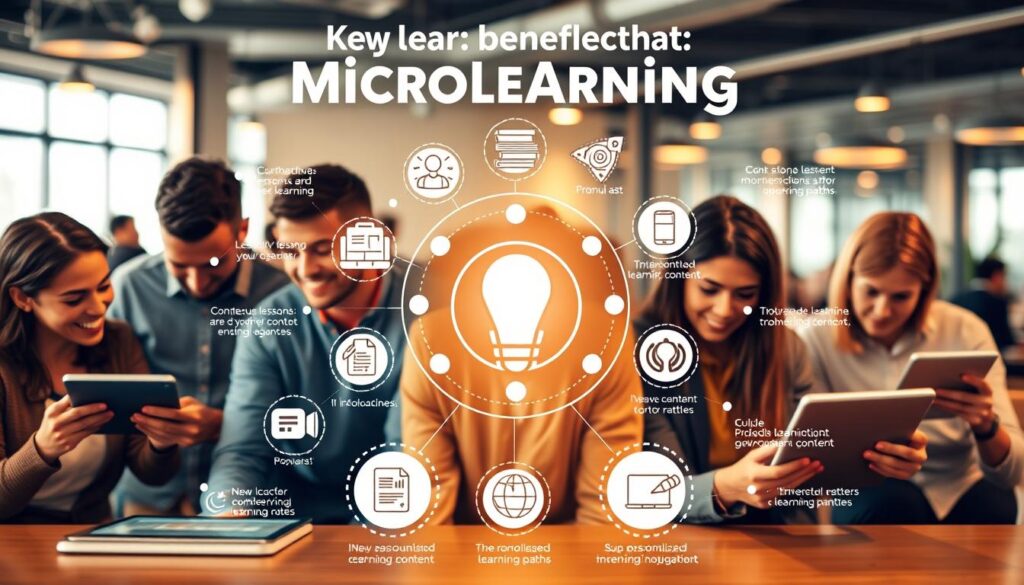Did you know that employees are 65% more likely to retain information when it’s delivered through concise, focused learning modules?
This statistic underscores the growing importance of effective microlearning strategies in enhancing workplace skills. As organizations strive to upskill their workforce efficiently, microlearning has emerged as a pivotal tool. It offers a flexible, engaging, and impactful way to deliver training.
By leveraging microlearning examples for workplace skills, businesses can create targeted training programs that address specific needs. This approach not only boosts employee performance but also aligns with the modern workplace’s dynamic environment.
Key Takeaways
- Microlearning enhances information retention by delivering concise learning modules.
- Effective microlearning strategies are crucial for upskilling the workforce.
- Targeted training programs can be developed using microlearning examples.
- Microlearning aligns with the dynamic environment of the modern workplace.
- It offers a flexible and engaging way to deliver training.
Understanding Microlearning in the Workplace
As the modern workplace continues to evolve, microlearning has emerged as a key strategy for delivering effective, bite-sized training that meets the needs of today’s employees. This approach to learning is designed to be concise, accessible, and highly relevant, making it an ideal solution for workplace training.
What is Microlearning and Why It Matters
Microlearning involves breaking down learning content into smaller, manageable chunks, allowing employees to absorb information more easily and quickly. This method is particularly effective in today’s fast-paced work environment, where employees need to acquire new skills rapidly to remain competitive. By focusing on specific skills or knowledge areas, microlearning enables employees to learn at their own pace, reducing the cognitive overload often associated with traditional training methods.
Key Benefits of Microlearning for Employee Development
The benefits of microlearning for employee development are multifaceted. Some of the key advantages include:
Improved Knowledge Retention
Microlearning enhances knowledge retention by presenting information in a concise and focused manner, reducing the likelihood of information overload. This leads to better recall and application of learned skills.
Increased Engagement and Completion Rates
By making learning more accessible and manageable, microlearning increases employee engagement and completion rates. Employees are more likely to participate in training when it’s delivered in short, manageable chunks.
Cost and Time Efficiency
Microlearning is also cost-effective and time-efficient, as it reduces the need for lengthy, in-person training sessions. This approach saves both time and resources, making it an attractive option for businesses.

By understanding and leveraging microlearning, organizations can create a more efficient, effective, and engaging training program that supports the ongoing development of their employees.
Microlearning Examples for Workplace Skills
In today’s fast-paced work environment, microlearning has emerged as a key strategy for enhancing employee skills. By delivering training in bite-sized, focused modules, organizations can efficiently address the diverse learning needs of their workforce.
Technical Skills Microlearning Examples
Technical skills are crucial for many industries, and microlearning offers an effective way to develop and update these skills. For instance, software training micro-modules can guide employees through new software features or updates.
Software Training Micro-modules
These micro-modules are designed to be concise and interactive, often including step-by-step guides, videos, or interactive simulations. For example, a company implementing a new CRM system could create micro-modules that cover data entry, contact management, and sales tracking.
Process-Specific Tutorials
Process-specific tutorials are another valuable microlearning tool, providing detailed instructions on complex processes or procedures. These tutorials can be particularly useful in industries with strict regulatory requirements, such as finance or healthcare.
Soft Skills Development Through Microlearning
Soft skills, such as communication and leadership, are equally important for workplace success. Microlearning can be tailored to develop these skills through targeted lessons and activities.
Communication Micro-lessons
Effective communication is critical in any workplace. Micro-lessons on communication might include tips on active listening, clear writing, or conflict resolution. These lessons can be delivered through video, interactive quizzes, or gamified learning experiences.
Leadership Skill Building
Leadership skills can also be developed through microlearning. Modules might focus on strategic planning, team management, or decision-making, providing leaders with the insights and tools they need to succeed.
Compliance Training Microlearning Examples
Compliance training is a critical aspect of many organizations, particularly in regulated industries. Microlearning can simplify compliance training by breaking it down into manageable, easily digestible modules.
“Microlearning has transformed our compliance training program, making it more engaging and effective.”
| Skill Category | Microlearning Example | Benefits |
|---|---|---|
| Technical Skills | Software Training Micro-modules | Quickly updates employees on new software features |
| Soft Skills | Communication Micro-lessons | Improves team collaboration and reduces misunderstandings |
| Compliance Training | Regulatory Update Modules | Ensures employees are up-to-date with the latest regulations |
Effective Microlearning Formats and Delivery Methods
To maximize learner engagement, organizations are adopting various microlearning formats and delivery methods. This approach allows for a more personalized and effective learning experience, catering to the diverse needs of modern learners.
Video-Based Microlearning Examples
Video-based microlearning has gained popularity due to its ability to convey complex information in an easily digestible format. Short, focused videos can be used to demonstrate new skills or explain procedures, making them an effective tool for technical skills training. For instance, a company might use video tutorials to train employees on new software or equipment operation.
Interactive Quizzes and Gamified Learning
Interactive quizzes and gamified learning elements introduce a competitive and engaging aspect to microlearning. By incorporating game design elements and interactive assessments, organizations can increase learner participation and retention. This method is particularly effective for soft skills development, where scenario-based learning can be highly beneficial.
Infographics and Visual Microlearning
Infographics and visual microlearning content leverage the power of visual communication to convey information quickly and effectively. Visual aids like infographics can simplify complex data, making it easier for learners to understand and remember key points. This format is ideal for compliance training and other areas where data needs to be presented clearly.
Mobile Microlearning Solutions
With the rise of mobile device usage, mobile microlearning solutions have become increasingly popular. These solutions allow learners to access training content anywhere, anytime, enhancing flexibility and convenience. Mobile microlearning can be particularly effective when combined with other formats, such as video or interactive quizzes, to create a comprehensive learning experience.
By leveraging these diverse formats and delivery methods, organizations can create engaging microlearning content that meets the needs of their learners, ultimately enhancing the effectiveness of their training programs.
Microlearning Tools and Platforms
Microlearning tools and platforms play a crucial role in enhancing workplace training through concise and focused learning experiences. To effectively implement microlearning, organizations must select the right tools and platforms that align with their training objectives.
Learning Management Systems with Microlearning Capabilities
Many modern Learning Management Systems (LMS) have incorporated microlearning capabilities, allowing organizations to deliver bite-sized training content. These LMS platforms offer features such as mobile accessibility, content authoring tools, and analytics to track learner engagement and performance.
Dedicated Microlearning Platforms
Dedicated microlearning platforms are designed specifically for creating and delivering microlearning content. These platforms often provide user-friendly interfaces for content creation, personalization options, and integration with existing HR systems. They cater to the unique needs of microlearning, offering a streamlined approach to skill development.
Content Creation Tools for Microlearning
Content creation is a critical aspect of microlearning. Various tools are available for creating engaging microlearning content, including video editing software, interactive quiz builders, and infographic creators. These tools enable trainers to develop high-quality, engaging content that resonates with learners.
By leveraging these microlearning tools for skill development and utilizing appropriate microlearning platforms, organizations can enhance the effectiveness of their training programs and improve employee performance.
Implementing Microlearning in Your Organization
Implementing microlearning effectively requires a deep understanding of your organization’s specific training needs. By tailoring microlearning strategies to address these needs, organizations can enhance employee development and improve overall performance.
Creating a Comprehensive Microlearning Strategy
A comprehensive microlearning strategy involves identifying key areas where microlearning can have the most impact. This includes assessing current training programs, understanding employee skill gaps, and determining the most effective microlearning formats for your audience. Microlearning best practices suggest starting small, piloting programs, and iteratively improving based on feedback.
Integrating Microlearning with Existing Training Programs
To maximize its effectiveness, microlearning should be integrated with existing training programs. This involves aligning microlearning modules with broader learning objectives and ensuring that they complement traditional training methods. By doing so, organizations can create a seamless learning experience that leverages the strengths of both approaches.
Measuring Microlearning Effectiveness
Measuring the effectiveness of microlearning is crucial to understanding its impact and identifying areas for improvement. This can be achieved through various metrics and feedback mechanisms.
Key Performance Indicators
Key performance indicators (KPIs) for microlearning may include completion rates, quiz scores, and application of learned skills on the job. By tracking these KPIs, organizations can assess the effectiveness of their microlearning initiatives.
Feedback Collection Methods
Collecting feedback from learners is another critical aspect of measuring microlearning effectiveness. This can be done through surveys, focus groups, or direct feedback mechanisms within the microlearning platform. Feedback helps in understanding learner satisfaction and identifying areas for improvement.
Overcoming Implementation Challenges
Despite its benefits, implementing microlearning can come with challenges, such as resistance to change or technological limitations. To overcome these challenges, organizations should focus on change management, providing clear communication about the benefits of microlearning, and investing in user-friendly technology platforms that support microlearning delivery.
Conclusion
As organizations continue to evolve, the need for effective and efficient training methods has become paramount. Microlearning has emerged as a powerful tool in workplace training, offering a range of benefits that enhance employee development and productivity.
By incorporating microlearning examples for workplace skills, such as technical skills, soft skills, and compliance training, organizations can provide targeted training that meets the needs of their workforce. Effective microlearning strategies, including video-based learning, interactive quizzes, and mobile solutions, can be tailored to suit various learning styles.
The key to successful microlearning implementation lies in creating a comprehensive strategy that integrates with existing training programs and measures effectiveness. By doing so, organizations can overcome implementation challenges and reap the rewards of a well-trained and adaptable workforce.
As the workplace continues to evolve, embracing microlearning can be a crucial step in maximizing workplace potential and driving business success.
